文章信息
- Zhang Yang, Ma Yan
- 张杨, 马岩
- Mechanical Properties and Finite Element Analysis on Medical Neck Collar Made of Micron Wood Fiber
- 微米木纤维医用颈椎夹板的力学性能及有限元分析
- Scientia Silvae Sinicae, 2017, 53(4): 129-138.
- 林业科学, 2017, 53(4): 129-138.
- DOI: 10.11707/j.1001-7488.20170415
-
文章历史
- Received date: 2016-04-15
- Revised date: 2016-07-13
-
作者相关文章
In recent years, because of the enhanced requirements for biomedical materials, especially for their mechanical properties (Chandra et al., 1998; Yang et al., 2008), for biomedical materials mechanics performance requirements more stringent, traditional metal and alloying non-metal materials in the process of manufacturing of medical materials is more and more cannot satisfy the use requirement(Diao et al., 1996; Ma, 2003). For example, new material with good absorbability, permeability, and compatibility with human skin is required to make elastic and plastic light materials (Zhan et al., 2003; Xi, 2006).
Micron-size wood fiber as a biomedical material is a kind of advanced material-as the base material. A new fiber process technology produces longer micron fiber than traditional and artificial board fiber (Yoshioka et al., 2003; Yang et al., 2008). Its thickness is less than the traditional artificial board fiber, and they have used for mold pressing to fabricate specific shapes and reach specific performance indices in medicine (Ma, 2001; 2002).
Comparing with traditional wood, the medical instruments made from this kind of wood fiber in micron have the advantages of better air permeability, compatibility, high compression ratio, and high toughness modulus for human skin (Maekawa et al., 1999, Hill et al., 1999). Nowadays, thanks to the development of micron technology and micron wood fiber process technology, non-defective imitation wood is made from recombinant wood fiber by changing the cell arrangement (Singh et al., 2001). With almost pure wood fiber, micron recombinant orientational fiber board was produced, it is with unidirectional strength and similar to various steels (Watanabe et al., 1999).
Our investigation focused on mechanical properties analysis of a neck collar made of micron wood fiber. According to modern theory on designing a collar made for treating bone fractures, theoretically, researched the characteristics of a bone-fracture neck collar from the microstructure angle (Wang et al., 2001) of the material. We analyzed how to build a reasonable finite element model for a micron wood fiber neck collar and achieved the performance results we were looking for, using ABAQUS software.
1 Materials and methods 1.1 Materials preparationWhen making the neck collar, wood is shaved by a cutting machine along the fiber direction to get the micron wood fiber to a thickness of 21 μm. Wood fiber at this level is soft, so the pressed neck collar has better compatibility with human skin. Considering the size of the neck collar, the wood fiber should be molded into filaments (Fig. 1a) with a width of 2-6 mm and a length of 12-28 mm by the crusher. Type 14L960 polyvinyl acetate emulsion was selected as the adhesive because of its suitability of the adhesion of wood fiber materials with better economical efficiency. It has a pH value of 6.5-7.0, a viscosity of 1.6-2.3 Pa·s, dry strength of 8-12 MPa and wet strength of 5.7-7.2 MPa. Polyvinyl acetate adhesive, of which the composition are synthesized by polyvinyl acetate(64%) and poval(29%) with water(7%) added, is used as the adhesive because it can cure at room temperature, cure fast, with higher adhesive strength.

|
Fig.1 Wood fiber morphology of Pinus koraiensis after planning and the neck collar after mould pressing a. Micron wood fiber morphology; b. Material object picture after mould pressing. |
The mold-pressed wood-fiber neck collar (Fig. 1b) is first mixed and then pressed using the 16 μm diameter wood fiber and adhesives. Fig. 2 is the microstructure picture of the wood-fiber surface, which shows that the wood fiber and the adhesives are well combined with no obvious interface defects. Due to the random distribution of wood fiber in a neck collar, the unidirectional porous structure in the wood fiber is distributed in all directions inside the neck collar, and the porous structure presents as three-dimensional. This way, a preparative neck collar can maintain a certain strength and high toughness in all directions, which will improve the comfort and therapeutic effect of this kind of neck collar. According to Fig. 3, under the function of the adhesive after the mold and press, the wood fiber is combined with no stratification, which proves that the preparation technology is reasonable.
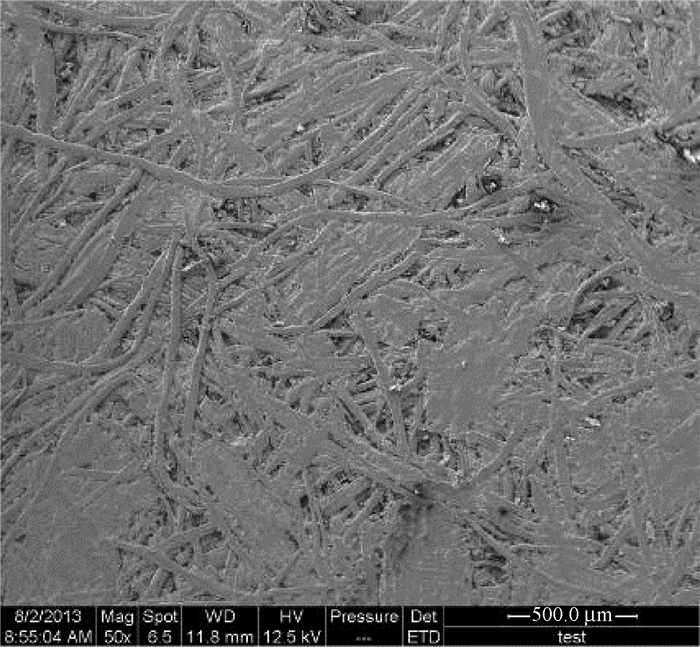
|
Fig.2 The microstructure picture of the wood fiber surface |
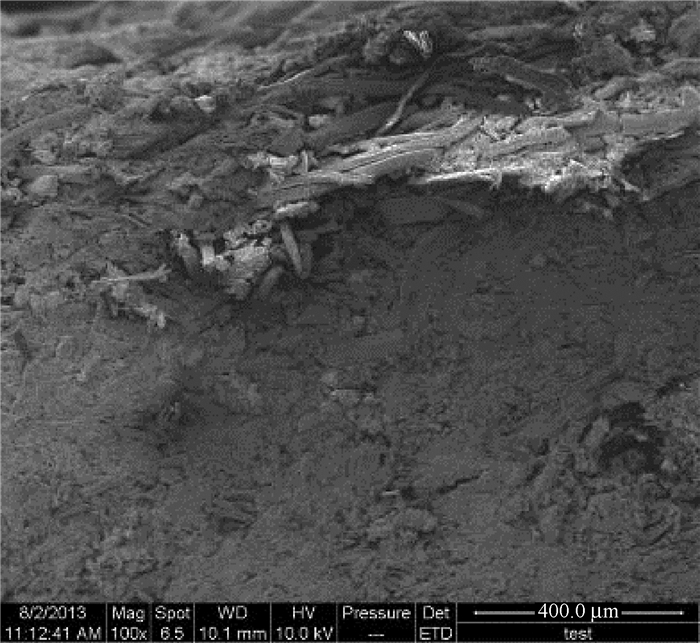
|
Fig.3 The scan picture of micron wood fiber neck collar |
Firstly, we test the mechanical properties of micron wood fiber material. Then we apply the three-point bending test on wood-fiber materials, which are 120 mm × 20 mm × 10 mm (length × width × height). According to European standard EN310—1989, EN3191995, as well as the national standard GB/T17657—1999, take specimen making and testing, in the SANS-CMT5504 universal mechanical testing machine, using three point bending method to determine the material's elastic modulus and static bending strength. Type MW-4 mechanical testing machine for wood is used to test the impact toughness of the specimen.
The analysis of the mechanical curve of the wood-fiber material, a mathematical model of a neck collar with the physiological parameters of human vertebrae vertebra is built. According to the established mathematical model and neck collar material parameters, we one completes the statics analysis of the model with ABAQUS.
2 Results and discussion 2.1 The mechanical properties of the micron wood fiber materialsIn order to provide a reference basis to the finite-element static analysis of the neck collar in a later period, a three-point bending mechanical test of wood fiber board is required. The stress-strain bending curve of the wood fiber board is seen in Fig. 4. Along with straining, the mechanical properties of the curve also presents an obviously rising trend, but when the strain reaches 3%, the bending stress of material reaches the maximum, which is 30 MPa. Then the mechanics of the curve begins to fall suddenly, which illustrates that the materials have lost efficacy at the moment.
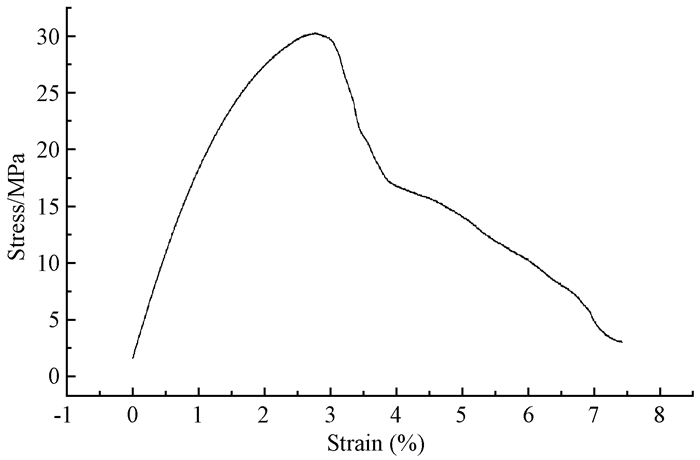
|
Fig.4 The stress-strain bending curve of the wood fiber board |
For fiber materials, only fibers with certain aspect ratio or the length greater than the critical length can contribute to the strength of composite materials, and fibers with length less than critical length are ineffective. Critical length can be measured according to the following formula (Guo, 1994):
| $ L = {\sigma ^*}\gamma /\tau . $ | (1) |
where: σ is the tensile strength of carbon fiber (MPa); γ is the radius of carbon fiber (mm); τ is the interfacial shear strength.
Observation of bent micron wood fiber material has been completed. As shown in Fig. 5, it can be found that the center part of the entire sample is bent and deformed to a certain extent; load is applied on the surface wood fiber, after the interlayer wood fiber is under stressed, the load is passed to the outermost layer of wood fiber and the bending deformation is formed, seen as the microstructure pointed by Arrow A in Fig. 6. There are scanning electron micrographs of fracture morphology of outermost layer in micron wood fiber material as shown in Fig. 7.
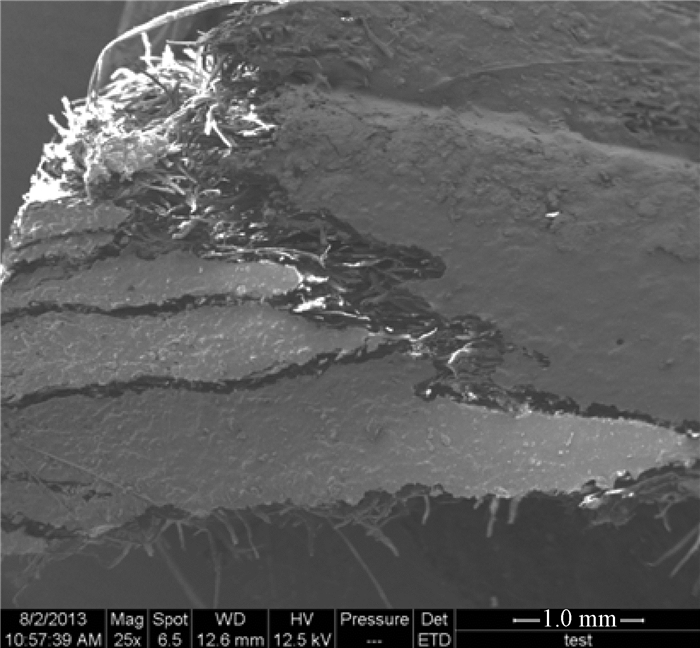
|
Fig.5 The macroscopic damage morphology of carbon fiber reinforced wood-based composite materials |

|
Fig.6 The scan picture of wood fiber board fracture morphology |

|
Fig.7 he scan pictures of carbon fiber reinforced wood-based composite materials a.Interface bonding state; b.Single carbon fiber bundle. |
There is damage in the interlayer of wood fiber board and the damage is inside the interlayer wood fiber board as pointed by Arrow B in Fig. 6. To use scanning electron microscope to observe the microstructure pointed by Arrow C in Fig. 6 and find the interfacial bonding between the wood fiber bundles is still good. Meanwhile, in Fig. 5, it can be observed clearly that there is no delaminating phenomenon between layers, which indicates the strength of adhesive is strong and it can meet the strength requirement when material is under the stress. The test result shows the selection of adhesive is reasonable, it has relatively high working strength and it can transfer the load well when material is under the stress.
2.2 Finite element analysis of statics 2.2.1 The establishing of the modelThe paper sets up a 1:1 finite element model via ABAQUS finite element software and unit of finite element model is subject to the standard unit.Fig. 8 and Fig. 9 are dimension figures of front and back of micron wood fiber neck collar respectively.
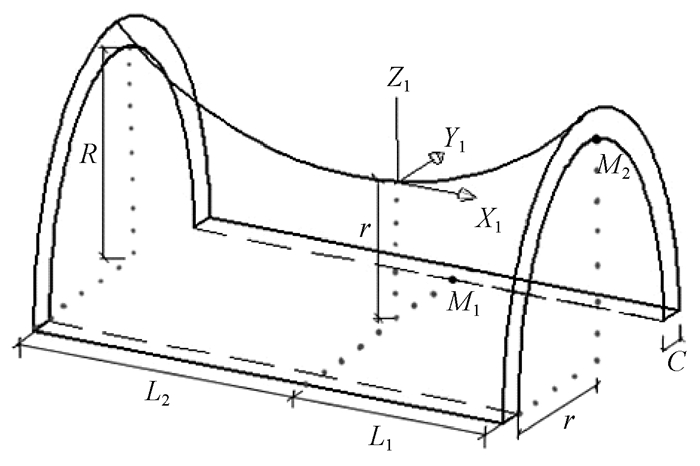
|
Fig.8 The mathematical model of front neck collar |

|
Fig.9 The mathematical model of back neck collar |
L2:length of upper neck of human body; L1:length of lower neck of human body; R:maximum radius of human neck; r:minimum radius of human neck; C:thickness of neck collar. Tab. 1 is the geometrical parameters of micron wood fiber neck collar.
|
|
According to the given dimensions, the implementation of solid modeling has been completed. As the structure has curved surface, firstly model a elliptic cylinder body and delete the redundant part via Boolean combination data so that the required numerical data can be acquired. Fig. 10a is the model of front micron wood fiber neck collar and Fig. 10b is the model of back micron wood fiber neck collar. The main difference between the front model and back model is the difference of lengths of upper and lower human neck.

|
Fig.10 The model of front micron wood fiber neck collar (a) and the model of back micron wood fiber neck collar(b) |
To partition the structure by grid, adopt grid adaptive technology and self-control finite element to analyze the density of grid and formulate corresponding error criterion. Unit number partitioned on the front micron wood fiber neck collar is 173 953 and unit number of back neck collar is 221 935.
2.2.3 Failure criterion of the materialBecause micron wood fiber neck collar has anisotropy and complex micro-structure, the failure mechanism is relatively complex. The maximum principle strain failure criterion is adopted in the paper, which means when the strains in the units reach the strain limits of materials, the units are ineffective without bearing capacity any more.
2.3 Compression simulation from inside to the outside along curved surface corresponding to upper neck lengthABAQUS finite element software is used in this paper in order to carry out numerical simulation, below are the material parameters needed of the unit in the simulation and properties needed to be given to the unit. The material property model of micron wood fiber neck collar is anisotropy. There are 7 parameters need to be input: shear modulus G12, G23, G13, elasticity modulus E11, E22, Poisson's ratio v and density. Tab. 2 is the mechanical property of of micron wood fiber.
|
|
Micron wood fiber neck collar has certain pressure bearing capacity and deformation forms at the same time. Meanwhile, the thickness of the board is far less than the sizes of the other two directions. Therefore, in this paper, shell element is used as the transition element to simulate the semi-rigidity element of the neck collar.
2.3.1 Load and boundary conditionsDue to the random distribution of wood fiber in the neck collar in the preparation process, unidirectional porous structures inside the wood fiber also distribute in different directions. Porous structures show three-dimensional characteristics which make the neck collar can retain certain strength and gain high toughness at the same time. This meets the orthotropic material condition in mechanics of composite materials, thus enhanced the utilization strength of the neck collar with this complex structure. There are two compression modes for micron wood fiber in the paper. One is to compress micron wood fiber neck collar from outside to the inside along the side curved surface (simulating the possible compression when not in use) and the other one is to compress the neck collar from inside to the outside along the curved surface corresponding to upper neck length. When the neck collar is compressed from the inside to the outside along the curved surface corresponding to the upper neck length (simulating the compression in the actual use), set the bottom surface as fixed constraint, which means displacements in X, Y and Z directions and all the rotation degree of freedom are constrained. Upper curved surface is loaded subject to quasi-static displacement.
To extract element counterforce of bottom surfaces on both sides and whole stress distribution information to acquire the load limit of the entire structure after the calculation. Fig. 11a is the load surface; Fig. 11b is fixed constraint surface. Fig. 12 is the equivalent stress nephogram of compression from inside to the outside along the curved surface corresponding to upper neck length.
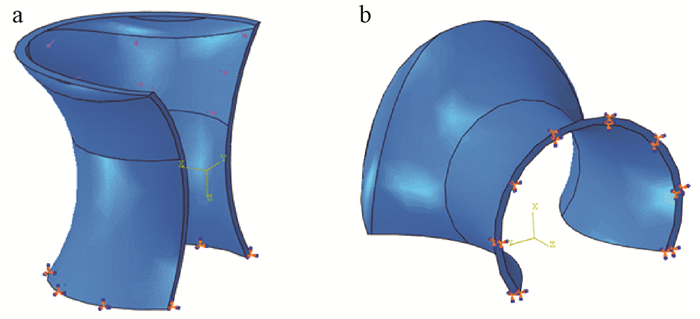
|
Fig.11 Load surface(a) and fixed constraint surface (b) |
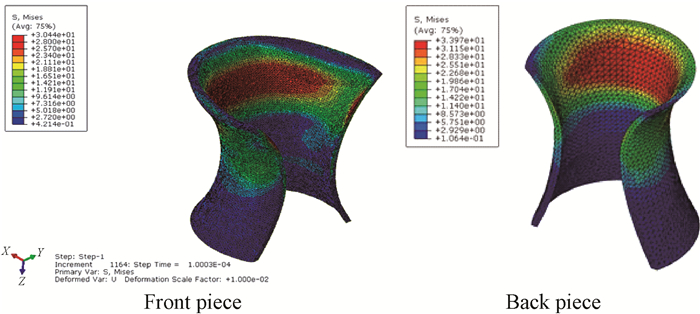
|
Fig.12 Stress distribution for the compression on curved surface |
Stress distribution results of compression from inside to the outside along the curved surface corresponding to the upper neck length show that the stress is mainly concentrated on the curved surface of upper neck and the upper edge of side surfaces shows the stress concentration. As micron wood fiber neck collar is symmetrical, the stress distribution is symmetrical as well. With the increase of load, the stress is spread to the entire curved surface gradually. For the front micron wood fiber neck collar, damage shows as fracture appears in bottom edge. For the back micron wood fiber neck collar, damage occurs on the curved surface of upper neck and fracture appears in the middle part of outer edge. Fig. 13 is the damage status when the micron wood fiber neck collar is compressed from inside to the outside along the curved surface corresponding to the upper neck length.
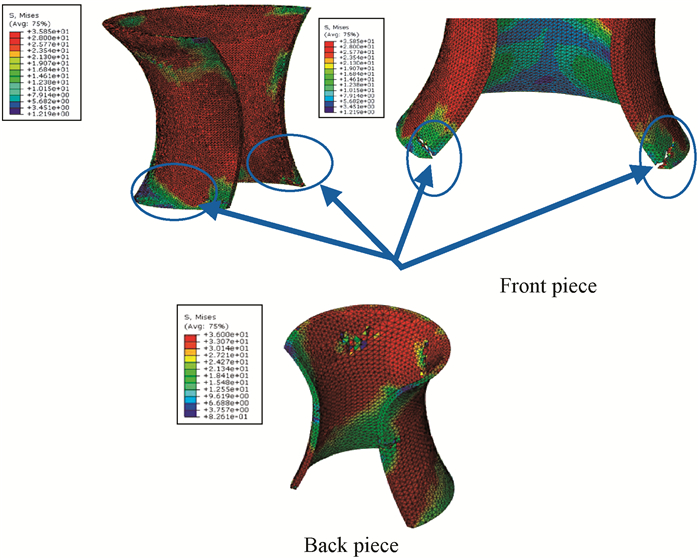
|
Fig.13 Stress distribution for the compression on curved surface |
To formulate a data report of model subsets and determine the constraint counterforce of the bottom surface in three directions in the report. Components of the total constraint counterforce of this set of nodes are included in the row "Total". Fig. 14 is the stress-strain bending curve for compression from inside to the outside of micron wood fiber neck collar along the curved surface corresponding to the upper neck length. It can be known from the Figure that the bearing capacity of back micron wood fiber neck collar is slightly higher than that of the front neck collar. From the stress nephogram, the maximum stress value in the back part of the neck collar is 33.79 MPa. It is very close to the maximum stress value of 30 MPa in the three-point bending test. These results show that the finite element model has been established correctly. The error is mainly due to the differences in modeling and dimension.

|
Fig.14 Stress and strain bending curve for compression |
Impact body is a rigid sphere with a radius of 15 mm. It has slight shape change in the impact process. To improve the accuracy and speed of calculation, rigid model in the finite element simulation is adopted and the impact speed of the rigid sphere is set as 10 m·s-1.
2.4.2 Load boundary conditionsThe paper simulates the fixed boundary conditions for front and back of the neck collar by constraining displacements in X, Y and Z directions of nodes in the junction surface of front and back micron wood fiber neck collar; the impact ball is moving in vertical direction at the speed of 10 m·s-1, displacements and corners in other directions are constrained. By setting different speeds of rigid sphere, impacts with different energies have been simulated on the model. Impact displacement is the interface between the border of upper and lower necks and axis. Fig. 15 is the rigid sphere before the impact and status of impacted neck collar.

|
Fig.15 Rigid sphere and front micron wood fiber neck collar (a) and rigid sphere and back micron wood fiber neck collar (b) |
Fig. 16 shows the changes of micron wood fiber neck collar under the impact load at different moments in the simulation. The Figure shows, when the time of contact between the rigid sphere and neck collar is prolonged, the deformation of the neck collar is increased. From the perspective of impact process of micron wood fiber neck collar, when the energy is 5 J, the neck collar is not damaged, the stress and deformation are distributed symmetrically. As the constraints on both ends of fixed component are symmetrical, the impact load is symmetrical as well. When the energy is 10 J, the neck collar is penetrated.
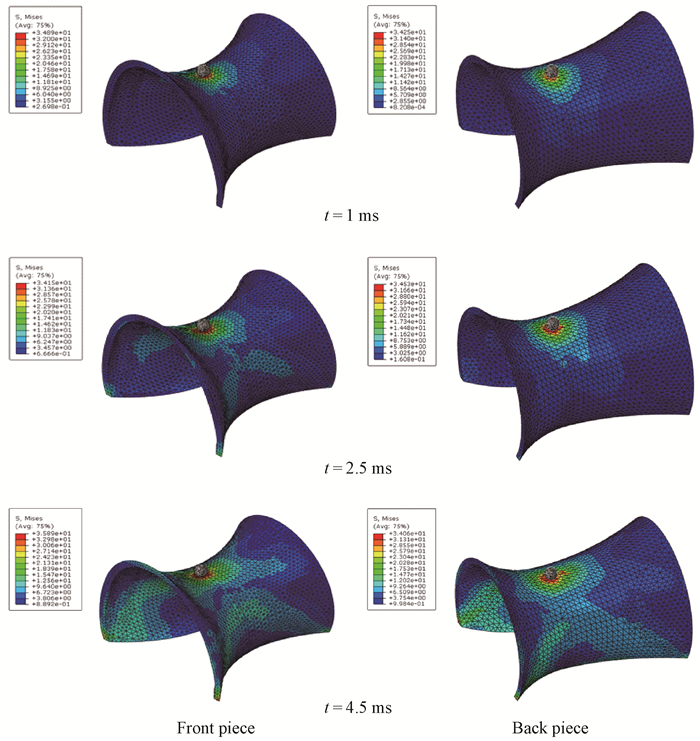
|
Fig.16 Damage morphology of neck collar under 5 J impact energy |
Fig. 17 shows the impact damage of numerical simulation results when the impact for micron wood fiber neck collar is 10 J. The damage degree of neck collar is shown in different color: red means the composite material's losing effect basically; gray means the material loses effect approximately; blue means the material is in good condition. White means the gird is deleted for the excessive deformation after the material's losing effect.
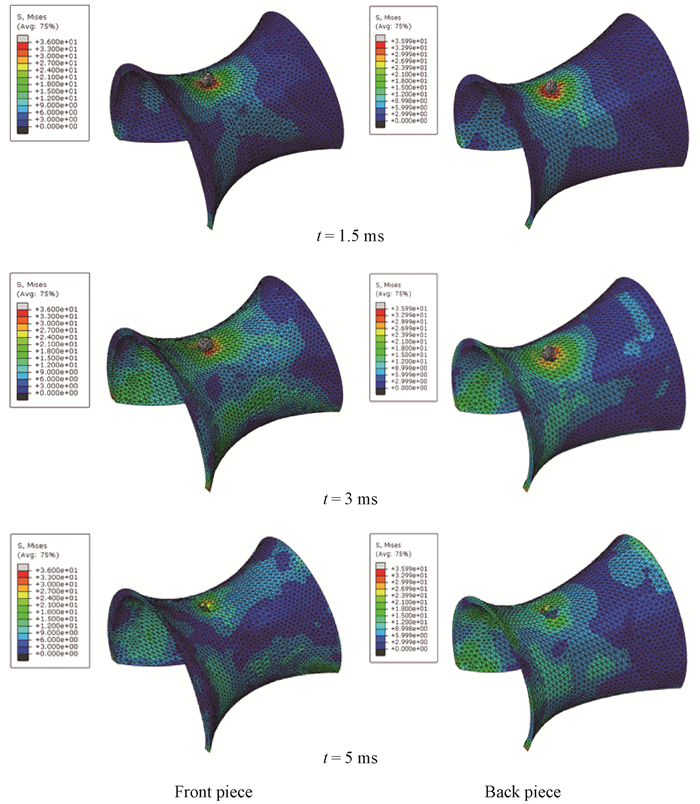
|
Fig.17 Damage morphology of neck collar under 10 J impact energy |
ABAQUS is adopted in the paper to analyze the dynamic response and relevant deformation of micron wood fiber neck collar under impact load and load-time curve, and energy absorption curve of neck collar are acquired. Impact resistance of neck collar under impact load is verified from perspectives of load and energy absorption.
It can be seen from Fig. 18 that the difference of peak loads produced in the impacts for the front sample is small when the impact energies are 5 J and 10 J respectively. However, the acting time of 10 J impact energy lasts longer and rigid sphere keeps partial energy after the sample is penetrated so that the energy absorptivity is relatively low. Fig. 19 is the response curve of back sample under different impact energy. As material properties and dimensions are approximate, difference of peak loads of energy on the front and back samples is small and the energy absorptivity of the front and back samples are approximate.

|
Fig.18 Response curve of front sample under different impact energy |
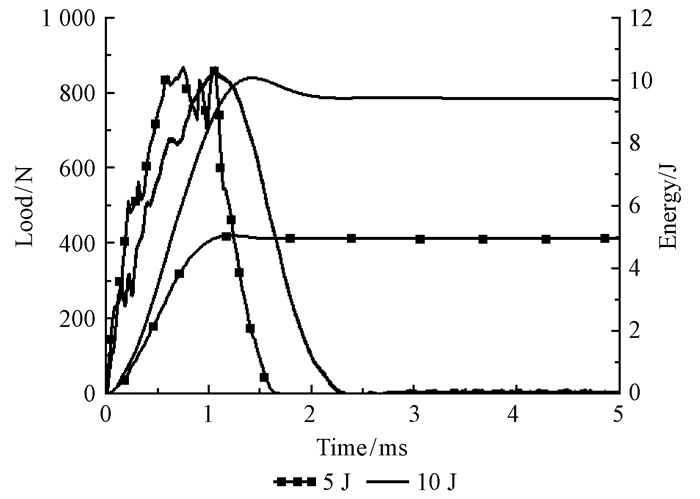
|
Fig.19 Response curve of back sample under different impact energy |
Numerical simulation results from the tests show the different mechanical properties of the front part and the back part of neck collar. The maximum stress value of 33.79 MPa meets the requirement of supporting human's head. The indexes of mechanical properties of the neck collar made of micron wood fiber are related to the density during compression molding which proves the rationality of compression molding density of strength. However, if the porosity under this compression molding density can meet the requirement of the absorption of sweat is still undetermined. The porosity is the main element of determining the moisture absorption and moisture absorption rate, the animation of researching on porosity is to prevent the skin follicle from inflammation. The research on the porosity of neck collar later can use the value of mechanical properties and the material die density in this essay for reference, in order to make better fiber cervical neck collar which can not only meet the strength requirements but also have better absorption for human sweat.
3 Conclusions1) It can be seen in the stress -strain bending curve of the three-point bending mechanical test, the mechanical property curve of wood fiber board has a sharp rising trend in the preliminary stage of strain. When the strain is 3%, the bending strain of the material can reach a maximum of 30 MPa, and then the mechanic curve suddenly drops thereafter, it means the material has lost effect at the moment.
2) Scanning electron microscope (SEM) is used to observe the microstructure in the fracture of micron wood fiber material and it can be observed clearly that there is no delaminating in the board, which means polyvinyl acetate adhesive has strong working strength and it can transfer load well under the stress.
3) When micron wood fiber neck collar is compressed from inside to the outside along the curved surface corresponding to upper neck length, the bearing capacity of back micron wood fiber neck collar is lightly greater than that of front neck collar. Stress resistance of micron wood fiber neck collar being compressed from outside to the inside along the side curved surface is higher than that when being compressed from inside to the outside along the curved surface corresponding to the upper neck length. The paper has studied the damage degree of micron wood fiber neck collar under low-speed impact via different impact energies and the impact damage is increased in line with the increase of impact energy.
| [] | Chandra R, Rustgis R. 1998. Biodegradable polymers. Prog Polym Sci, 16 : 22–66. |
| [] | Diao X, Furuno T, Uehara T. 1996. Analysis of cell arrangement in soft wood susing two-dimensional fast Fourier transformation. Mokuzaishi, 42(7) : 634–641. |
| [] | Guo Q S. 1994. Man-machine engineering design. Tianjin, China, Tianjin University Press: 56-79. |
| [] | Hill C A S, Jones D. 1999. Dimensional changes in Corsican Pine sapwood due to chemical modification with linear chain anhydrides. Holzforschung, 53(3) : 267–271. |
| [] | Ma Y. 2003. Study on cell break theory of using wood fiber micro-meter aligned reconstituted technology forming super high-strength wood-based panel. Scientia Silvae Sinicae, 39(3) : 111–115. |
| [] | Ma Y. 2001. Prospect nanometer and micrometer science and technology for applying to the wood industry. Scientia Silvae Sinicae, 37(8) : 109–113. |
| [] | Ma Y. 2002. Study on quantitatively calculated theory of micro-meter wood fiber directional reconstituted content of cell fiber. Journal of Biomathematics, 17(3) : 353–357. |
| [] | Maekawa T, Fujita M, Saiki H. 1999. Characterization of cell arrangement by polar coordinate analysis of power spectral patterns. J Soc Mater Sci Jpn, 42(473) : 126–131. |
| [] | Singh A P, Geoffrey D. 2001. The S2 layer in the tracheid walls of Picea abies wood: inhomogeneity in lignin distribution and cell wall. Holzforschung, 55(4) : 373–378. |
| [] | Wang Y Q, Zhang J W, Gang X Z, et al. 2001. Development and application of the neck collar. Chin J Radiol, 35(2) : 102. |
| [] | Watanabe U, Norimoto M. 1999. Tangential Young's modulus of coniferous early wood investigated using cell models. Holzforschung, 53(2) : 209–214. |
| [] | Xi T F. 2006. The current situation and developmental trend of biomedical materials. Thematic Forum (Material & manufacture), 12(5) : 1–4. |
| [] | Yang C M, Lv H, Ma Y. 2008. Fiber micro cutting theory and micron wood fiber formation mechanism research. Forestry Machinery & Woodworking Equipment, 36(5) : 22–24. |
| [] | Yoshioka T, Tsuru K, Hayakawa S, et al. 2003. Preparation of alginic acid layers on stainless-steel substrates for biomedical applications. Biomaterials, 24(17) : 2889–2894. DOI:10.1016/S0142-9612(03)00127-3 |
| [] | Zhan L, Yang C M, Ma Y. 2003. Study on theory of nano-micro-meter and micrometer wood fiber and its industrialized future. Forestry Machinery & Woodworking Equipment, 31(5) : 4–6. |
 2017, Vol. 53
2017, Vol. 53
